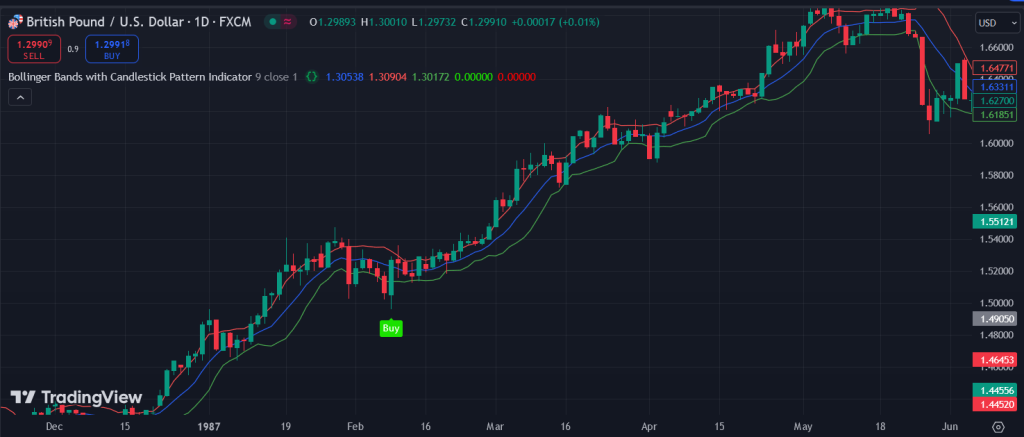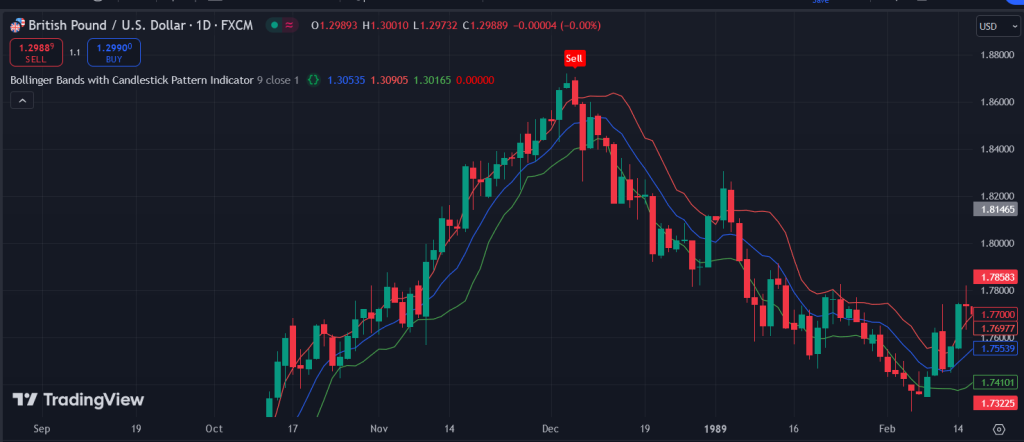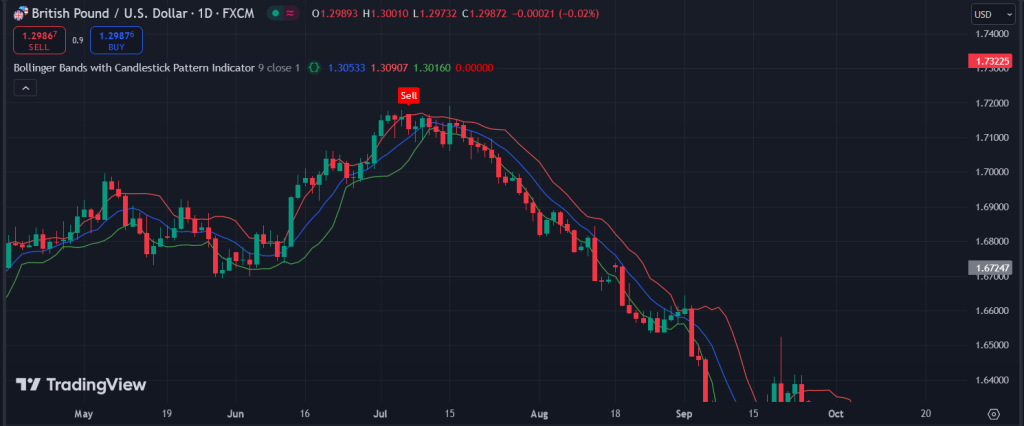🔓 Get All Tools for FREE!
- ✅ Click here to open a trading account using our referral link and start trading.
- 📅 After 7 days of active trading under our referral link, you can get access to all tools in your account.
- ⚠️ Keep trading to keep access free — if you're inactive for 7 days, your access will be removed.
- 👉 Already have an account? You can change the IB (introducing broker) to our referral link ( https://one.exnesstrack.org/a/w7syl3vnjb ) and still qualify!
Technical indicators are the backbone of effective trading strategies, allowing traders to make informed decisions by analyzing price movements and patterns. One such powerful tool is the Bollinger Band with Candlestick Pattern Indicator. This custom TradingView indicator combines two time-tested analysis tools—Bollinger Bands and candlestick patterns—to deliver actionable buy and sell signals. This article dives into how the indicator works and how you can leverage it to improve your trading results.
What is the Bollinger Band with Candlestick Pattern Indicator?
The Bollinger Band with Candlestick Pattern Indicator is a custom trading tool that fuses the volatility measurement of Bollinger Bands with the visual insights of candlestick patterns. Bollinger Bands are widely used to measure market volatility, while candlestick patterns offer a glimpse into market sentiment by highlighting potential reversals or continuations in price movements.
🔓 Get All Tools for FREE!
- ✅ Click here to open a trading account using our referral link and start trading.
- 📅 After 7 days of active trading under our referral link, you can get access to all tools in your account.
- ⚠️ Keep trading to keep access free — if you're inactive for 7 days, your access will be removed.
- 👉 Already have an account? You can change the IB (introducing broker) to our referral link ( https://one.exnesstrack.org/a/w7syl3vnjb ) and still qualify!
The indicator triggers buy and sell signals based on the interaction between the price and the Bollinger Bands, confirmed by specific candlestick formations. When the price touches the lower Bollinger Band and forms a bullish candlestick pattern, it signals a potential buying opportunity. Conversely, when the price touches the upper Bollinger Band and forms a bearish candlestick pattern, the indicator signals a potential sell.

Understanding Bollinger Bands
To fully grasp the power of this indicator, it’s essential to understand the Bollinger Bands. Developed by John Bollinger, Bollinger Bands consist of three lines:
- Middle Band: A simple moving average (SMA), typically a 20-period SMA.
- Upper Band: Plotted two standard deviations above the middle band.
- Lower Band: Plotted two standard deviations below the middle band.
Bollinger Bands adjust based on market volatility. During periods of high volatility, the bands expand, while they contract during low volatility. The price is expected to stay within the bands 90-95% of the time. When the price touches the upper band, the market is considered overbought; when it touches the lower band, the market is considered oversold.
The Role of Candlestick Patterns
Candlestick patterns are among the most popular tools for understanding price action. They represent a visual form of market sentiment by showing the relationship between the opening, closing, high, and low prices within a specific time frame.
Some key candlestick patterns used by this indicator include:
- Bullish Engulfing Pattern: A large green candle that fully engulfs the previous red candle, indicating a potential bullish reversal.
- Bearish Engulfing Pattern: A large red candle that fully engulfs the previous green candle, signaling a bearish reversal.
- Hammer: A candle with a small body and a long lower wick, often found at the bottom of a downtrend, signaling potential reversal.
- Shooting Star: A candle with a small body and a long upper wick, often found at the top of an uptrend, indicating a bearish reversal.
How the Bollinger Band with Candlestick Pattern Indicator Works
This TradingView indicator automates the process of detecting buy and sell signals by combining the strengths of both Bollinger Bands and candlestick patterns. Here’s a step-by-step guide on how it works:
- Bollinger Band Application: First, apply the Bollinger Bands to your chart. The indicator uses the standard settings (20-period moving average, 2 standard deviations) but can be customized based on your trading preferences.
- Pattern Detection: The indicator scans for key bullish and bearish candlestick patterns, such as bullish engulfing, bearish engulfing, hammers, and shooting stars. It looks for these patterns when the price touches either the lower or upper Bollinger Band.
- Buy Signal: When the price touches the lower Bollinger Band and forms a bullish candlestick pattern like a bullish engulfing or hammer, the indicator triggers a buy signal. This suggests that the market is oversold and could be ready for a reversal to the upside.
- Sell Signal: When the price touches the upper Bollinger Band and forms a bearish candlestick pattern such as a bearish engulfing or shooting star, the indicator triggers a sell signal. This suggests the market is overbought and could reverse to the downside.
Why Use This Indicator?
The Bollinger Band with Candlestick Pattern Indicator offers several benefits that can improve your trading:
- Automated Pattern Detection: No need to manually scan for patterns; the indicator highlights key candlestick formations as they occur, saving time and reducing human error.
- Enhanced Entry/Exit Timing: By combining price volatility with candlestick sentiment, the indicator helps you identify more accurate entry and exit points in your trades.
- Versatility: This indicator works well across various timeframes and markets, whether you’re trading stocks, forex, or cryptocurrencies.
- Confirmation Tool: The buy and sell signals generated can serve as confirmations for your existing trading strategies, providing additional confidence before making a trade.
Trading Example Using the Indicator
Let’s walk through a practical example of how you can use the Bollinger Band with Candlestick Pattern Indicator in your trading:
- Price Reaches Lower Band with a Bullish Engulfing Pattern: Suppose you’re analyzing a stock on a 15-minute chart. The price touches the lower Bollinger Band, and a bullish engulfing pattern appears. The indicator signals a potential buying opportunity. You enter the trade, placing your stop-loss below the recent low.
- Price Climbs Toward the Upper Band: As the price rises, it eventually touches the upper Bollinger Band. At this point, the indicator spots a bearish engulfing pattern, suggesting that the price might be overbought. You close your position to lock in profits.
- Sell Signal Confirmation: If you’re feeling aggressive, you could even open a short position based on the bearish signal, riding the downward move.
Tips for Using the Bollinger Band with Candlestick Pattern Indicator
- Adjust Bollinger Band Settings: Different assets and timeframes may require different settings for optimal results. For instance, you may need a 50-period moving average instead of the standard 20-period for longer-term trades.
- Combine with Other Indicators: Use this indicator alongside volume-based indicators, moving averages, or momentum indicators like the RSI (Relative Strength Index) for additional confirmation.
- Watch for Trend Strength: During strong trends, the price may ride the upper or lower band for extended periods. Avoid counter-trend trades without strong reversal signals.

Contact us at +91 7620658346 for access to this indicator. We offer algo development for TradingView indicators, MT4/MT5, and trading bots. Follow us on Instagram, YouTube, and Twitter @algo_aakash
Conclusion
The Bollinger Band with Candlestick Pattern Indicator is a valuable tool for traders looking to enhance their decision-making process. By combining two popular techniques—Bollinger Bands and candlestick patterns—this indicator helps you pinpoint optimal buy and sell signals, improving your trade timing and profitability. Whether you’re a beginner or an experienced trader, this indicator can add another layer of confidence to your trading strategy. Apply it on TradingView today to start seeing the benefits in your trades!
Disclaimer:
The information provided in this article is for educational purposes only and should not be construed as financial or investment advice. Trading in financial markets involves significant risk, and you should carefully consider your objectives, experience level, and risk appetite before engaging in any trading activities. The use of technical analysis tools such as the Bollinger Band with Candlestick Pattern Indicator does not guarantee profits and may result in losses. Always perform thorough research, seek advice from a professional financial advisor, and never invest money you cannot afford to lose. Past performance is not indicative of future results.

0 Comments